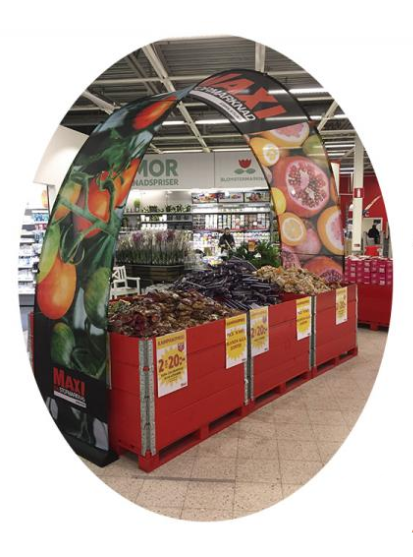Utomhusreklam är ett kraftfullt marknadsföringsverktyg som gör det möjligt för företag att nå ut till en bred publik i utomhusmiljöer. Det handlar om att visa reklambudskap, logotyper eller bilder på olika utomhusstrukturer, till exempel skyltar, evenemangsbågar, och banderoller. I den här artikeln kommer vi att utforska begreppet utomhusreklam och dess effektivitet för att fånga potentiella kunders uppmärksamhet.
Kraften i utomhusreklam
Utomhusreklam har flera fördelar som gör den till ett populärt val för företag. För det första har den en bred räckvidd, eftersom utomhusannonser är synliga för ett stort antal människor som passerar dem dagligen. Oavsett om det är en livlig gata, ett köpcentrum eller ett sportevenemang, har utomhusannonser potential att nå en mångsidig publik.
För det andra möjliggör utomhusreklam kreativa och iögonfallande mönster. Med hjälp av livfulla färger, djärv typografi och fängslande bilder kan företag skapa visuellt tilltalande annonser som fångar uppmärksamhet och lämnar ett bestående intryck på tittarna.
Bågar för evenemang: En unik lösning för utomhusreklam
En innovativ lösning för utomhusreklam är användningen av eventbågar från Bannerbow, en ledande leverantör av portabla presentationssystem. Dessa bågar kan användas som entréportaler, så att kunderna kan "passera igenom" varumärkets budskap när de kommer in i en butik eller ett evenemang.
Eventbågar är inte bara visuellt tilltalande utan också mångsidiga. De kan användas i olika detaljhandels- och butiksmiljöer för att presentera kampanjer och erbjudanden i butiken. Genom att placera bågarna över eller bredvid specifika produkter kan företag väcka kundernas intresse och nyfikenhet och på så sätt dra uppmärksamhet till sina kampanjer och erbjudanden.

Olika typer av utomhusreklam
Utomhusreklam omfattar olika typer av reklammetoder. Här är några vanliga typer:
1. Anslagstavlor
Billboards är stora utomhusstrukturer som visar reklam. De är strategiskt placerade i högtrafikerade områden för att maximera synligheten. Skyltarna kan vara statiska eller digitala, vilket möjliggör dynamiskt och engagerande innehåll.
2. Annonser om kollektivtrafik
Transitannonser visas på fordon i kollektivtrafiken, till exempel bussar, tåg och taxibilar. Dessa annonser kan nå en bred publik när de reser genom olika områden. Transitannonser kan lindas runt fordonen eller visas inuti.
3. Annonser för gatumöbler
Gatumöbelannonser avser annonser som placeras på föremål som busskurer, bänkar, kiosker och papperskorgar. Dessa annonser ger företag möjlighet att rikta in sig på specifika platser och engagera sig med fotgängare.
4. Digital skyltning
Digital signage innebär att man använder elektroniska skärmar för att visa upp annonser. Dessa skärmar finns på olika platser utomhus, till exempel i köpcentrum, på arenor och flygplatser. Digital signage möjliggör dynamiskt innehåll och uppdateringar i realtid.
Faktorer att ta hänsyn till vid utomhusreklam
Vid planering av en utomhusreklamkampanj bör företagen ta hänsyn till följande faktorer:
1. Val av plats
Att välja rätt plats för utomhusreklam är avgörande. Företag bör identifiera högtrafikerade områden där deras målgrupp sannolikt kommer att vara närvarande. Faktorer som synlighet, fotfall och demografi bör beaktas.
2. Målgruppsanalys
Att förstå målgruppen är avgörande för effektiv utomhusreklam. Företag bör genomföra marknadsundersökningar för att identifiera demografi, intressen och beteenden hos sin målgrupp. Denna information kan hjälpa till att utforma annonser som resonerar med de avsedda tittarna.
3. Designöverväganden
Utformningen av utomhusannonser spelar en viktig roll för att fånga uppmärksamheten. Annonser ska vara visuellt tilltalande, lätta att läsa och förmedla det avsedda budskapet snabbt. Tänk på faktorer som färgpsykologi, typografi och användning av bilder eller grafik.
4. Budgetering
Kostnaderna för utomhusreklam kan variera beroende på faktorer som plats, annonsstorlek och varaktighet. Företag bör upprätta en budget som stämmer överens med deras marknadsföringsmål och mål. Det är viktigt att ta hänsyn till kostnadseffektiviteten och den potentiella avkastningen på utomhusreklam.
Mätning av effektiviteten i utomhusreklam
Att mäta effektiviteten i utomhusreklamkampanjer är avgörande för att utvärdera deras effekt och fatta välgrundade beslut. Här är några metoder som används för att mäta effektiviteten:
1. Analys av fotgängarantal
Footfall-analys innebär att man spårar antalet personer som passerar eller besöker en specifik plats där utomhusannonser visas. Dessa data kan ge insikter om annonsernas räckvidd och exponering.
2. Undersökningar om varumärkeskännedom
Genom att genomföra undersökningar av varumärkeskännedomen före och efter en utomhusreklamkampanj kan man mäta effekten på varumärkeskännedom och varumärkesåterkallelse. Undersökningarna kan bedöma publikens kännedom om varumärket och deras förmåga att associera det med utomhusreklamen.
3. Digital spårning
Digitala spårningsmetoder, som QR-koder eller unika webbadresser, kan användas för att spåra det engagemang och de konverteringar som genereras av utomhusannonser. Dessa data kan ge insikter om hur effektivt det är att driva online-aktiviteter.
Framtida trender inom utomhusreklam
Utomhusreklam är ett område som ständigt utvecklas, drivet av tekniska framsteg och förändrade konsumentbeteenden. Här är några framtida trender att hålla utkik efter:
1. Digital integration
Digital integration blir allt vanligare i utomhusreklam. Interaktiva digitala skärmar, augmented reality-upplevelser och personaliserat innehåll förväntas öka engagemanget och skapa mer uppslukande utomhusreklamupplevelser.
2. Datadriven målinriktning
I takt med att dataanalysfunktionerna förbättras kommer utomhusreklamen sannolikt att bli mer målinriktad och personlig. Företag kan utnyttja datainsikter för att leverera relevanta annonser till specifika målgrupper baserat på faktorer som plats, demografi och intressen.
3. Hållbarhet och miljövänliga lösningar
Med ett växande fokus på hållbarhet förväntas utomhusreklamen anamma miljövänliga lösningar. Detta inkluderar användning av förnybara energikällor för digitala skärmar, återvinningsbara material för reklamstrukturer och miljömedvetna metoder under hela reklamprocessen.
Slutsats
Utomhusreklam är en dynamisk och effektfull marknadsföringsstrategi som gör det möjligt för företag att nå ut till en bred publik och skapa minnesvärda varumärkesupplevelser. Oavsett om det är genom evenemangsbågar, skyltar eller andra utomhusannonsformat kan företag utnyttja kraften i utomhusreklam för att fånga uppmärksamhet, öka varumärkesmedvetenheten och engagera sig med potentiella kunder.
Genom att beakta faktorer som val av plats, målgruppsanalys och effektiva mätmetoder kan företag optimera sina utomhusreklamkampanjer för att få maximal effekt. Om man tar till sig framtida trender och tekniska framsteg kan man ytterligare förbättra effektiviteten och relevansen av utomhusreklam i det föränderliga marknadsföringslandskapet.
